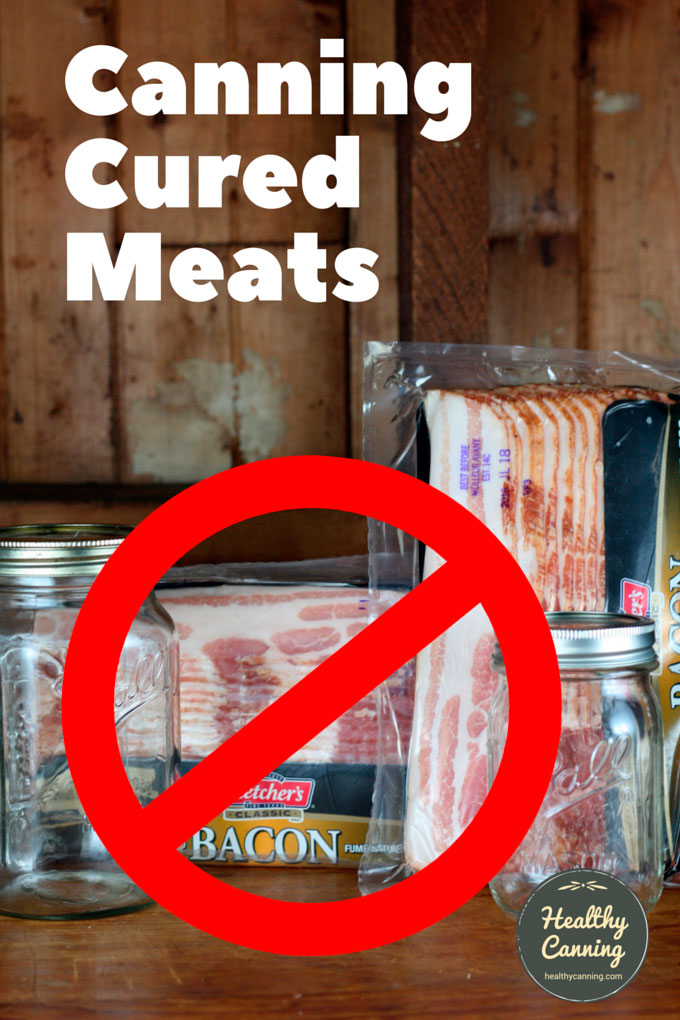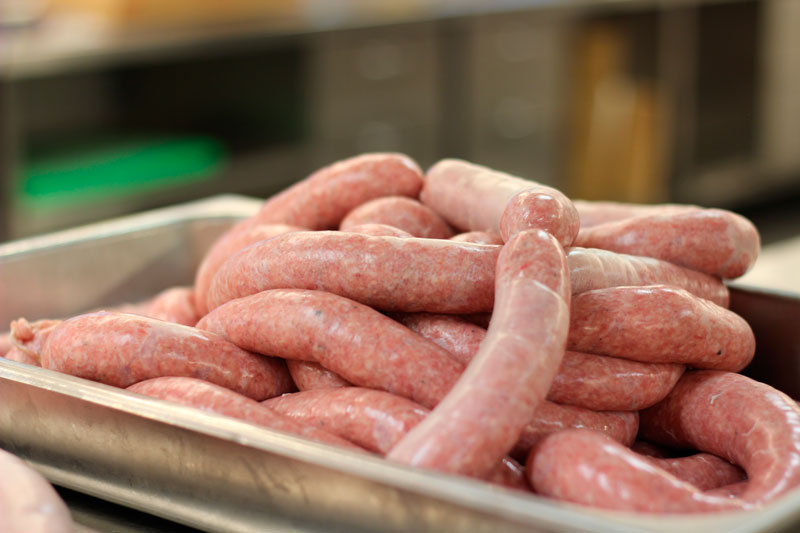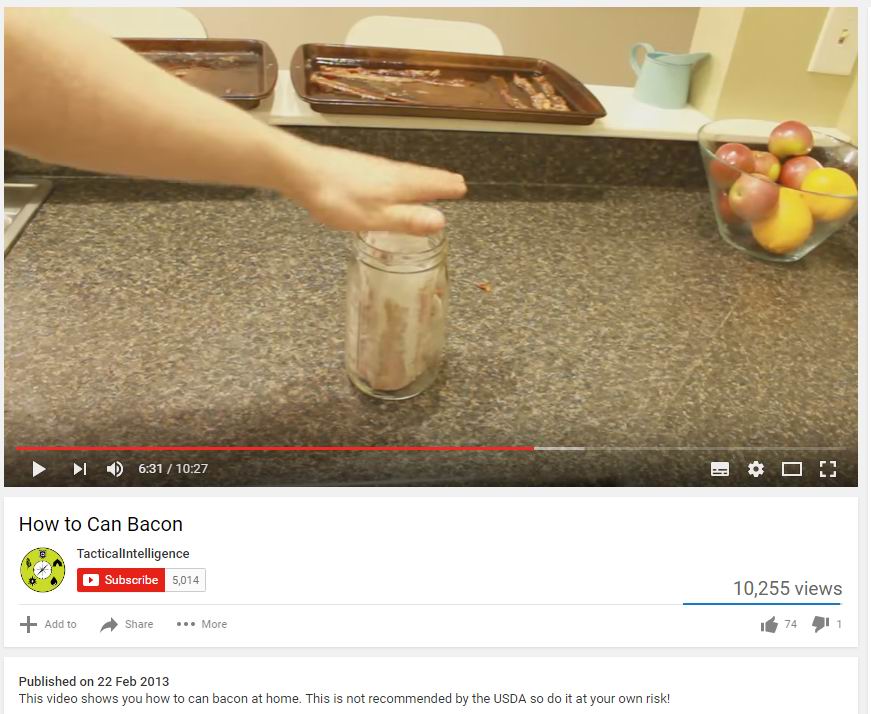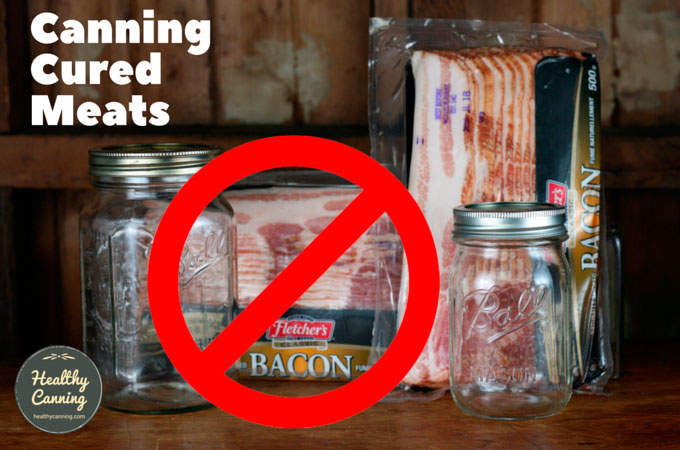
Can you home can cured meats?
The past few years there has been a “rasher” of breathless videos and blog posts purporting to impart to people the tightly-held secrets of home canning bacon, hams, pepperoni sausages, etc. The implication is that the reputable authorities in the home canning world either don’t know themselves, are too timid to try, or, are holding back on knowledge.
But, the reputable authorities actually do know all about the current state of affairs. Let’s see what they have to say on the matter.
You can’t home can cured meats.
That’s the message being clearly sent out from The National Center for Home Food Preservation and university Extension Services.
The category of “cured meats” includes various forms of bacon, brined meats, corned meats, ham, etc, as well as any dried and / or air-cured meats.
The issue is that the curing changes the density of the meat, and that changed density was never tested for safety.
The National Center for Home Food Preservation (NCHFP) says, “We cannot support the canning of cured, brined or corned meats with the procedures for fresh meats. We can only recommend canning meats, poultry and seafood as described in the following recommendations, using the cuts and preparation steps included.” [1]National Center for Home Food Preservation. Preparing and Canning Poultry, Red Meats and Seafoods. Accessed June 2016.
Note that the NCHFP is not trying to be mean or restrictive on purpose; they are being honest. They go on to say, “These are all the recommendations we have for meats, poultry and seafood.” [2]National Center for Home Food Preservation. Preparing and Canning Poultry, Red Meats and Seafoods. Accessed June 2016. In other words, they have handed us all the research-based (and therefore guaranteed to-be-safe) home meat canning techniques that they have in their toolkit. They are not holding anything back.
The only tested, safe recommendations that are currently known to all reputable authorities are for fresh (as opposed to cured) meat home canning. These recommendations were researched and developed from the 1930s to the 1950s, which is the last time the US government decided to invest a small amount of money in home meat canning research (they were reviewed in the 1980s to ensure that they were still valid.) When someone asks them for a safe way to home can meat, those are the only pages they have to flip through to pull out that information for them.
Susan Barefoot of Clemson University explains further, “The USDA legacy work in canning of meats at home is what we have.” [3] Barefoot, Susan. There is no safe approved process for home canning cured, brined or corned meats. Clemson University Extension, Canning Tip # 55. Accessed June 2016.
So why would cured meats be so different from the fresh meats that were studied? The texture of brined, corned or cured meat can often be different from that of “fresh” meat. For instance, it can be drier because moisture has been lost, which therefore makes it firmer and denser.
It’s entirely possible, therefore, that heat penetration would be slower, necessitating longer processing times. And the need for a different processing time is entirely possible — think about how fish turned out to be such a wildcard in pressure canning, pushing the processing times up to as much as 100 to 110 minutes and even requiring as well a special longer venting time before starting. Most YouTube video people probably would have “guessed”, wrongly, that using current meat processing times of 75 to 90 for fish would likely be too long because fish is more ‘delicate’. It took controlled research (done with a small amount of funding given to food science researchers in Alaska and Oregon) to bring to light the real processing requirements for home canning fish and seafood.
On the other hand, owing to preservatives such as nitrites and nitrates in some but not all cured meat, it could be that processing time should be shorter for a subset of cured meats — and if that were the case, using current meat processing times would cause the meat to be over-processed, and lower-quality, and the NCHFP would get flooded with complaints about that.
So besides the terrible liability if they were wrong, there’s just no upside to their guessing.
So to recap, all they have to go on are the legacy studies that were done in the 1930s to 1950s for canning of fresh meat. That small investment made in knowledge development and transfer has paid off a zillion times over since then — would that all government spending did — but since then, no further money has been invested in the subject of home canning any further meats.
It’s not that the home canning authorities are opposed to the idea of doing research on home canning cured meats. They would probably love to do it, if someone let them have the resources to do the project. In fact, their language may be code trying to signal that they’d love the go-ahead to do this:
“I think someone would have to come up with a worst-case scenario for heat penetration in all the possible variations and then do the testing.” [4] Barefoot, Susan. There is no safe approved process for home canning cured, brined or corned meats. Clemson University Extension, Canning Tip # 55. Accessed June 2016.
If you want the NCFHP or one of the USDA university extensions to develop recommendations for home canning of cured meats, contact your elected representatives and ask for them to be allocated a bit of funding to do it. After all, the government’s never not going to spend money: they mind as well direct a teeny bit to something that pays proven dividends for decades later.
Note : This also means no ham in your “Your choice” USDA soup recipes, and no bacon tossed into your home canned baked beans. The exception is if you are using tested recipes such as the ones mentioned below that allow for it.
Exceptions
People hate this part — they’d prefer everything be black and white, but life isn’t like that.
The exception to the above rule about no cured meats is IF a research-based recipe has been developed and tested incorporating them, proving the use safe in that recipe.
- Split Pea Soup with Ham. (Appears in Ball Blue Book, 2014, 37th edition, page 107, and in Bernardin Guide, 2013 as Habitant Soup, page 94.)
- Salt Pork is used in two Bernardin Guide recipes, Bean Soup (page 95), and Baked Beans with Pork, (page 97.)
- Bacon or Ham can be added to to one “So Easy to Preserve” recipe: “Fill hot jars ¾ full with hot beans. Add one ¾ inch cube of pork, ham or bacon to each jar, if desired. Do not add any more meat or bacon.” [5] Beans — Dry with Tomato or Molasses Sauce. In: Andress, Elizabeth L. and Judy A. Harrison. So Easy to Preserve. University of Georgia Cooperative Extension. Bulletin 989. Sixth Edition. 2014. Page 86. Also found in USDA Complete 2015, page 4-6.
- Safe processing times for smoked fish (note: fish only) have been determined through research and are available. The results are available on the NCHFP site.
Sausage

You can can fresh sausage. lehtta1 / Pixabay.com / 2013 / CC0 1.0
To be clear, you can can fresh sausage, just not dried or cured sausage. You can also use fresh sausage meat to make sausage patties and can those. You can use fresh meat to make meatballs, and can those.
Just nothing from meat that has been cured, or salted or dried in anyway.
Here is the USDA procedure for home canning fresh sausage (both Ball and Bernardin use the same USDA procedure.)
Bacon: no, you can’t home can bacon

Some of the bacon canning advice out there. Notice they even say “you’re on your own, Jack.”
Bacon counts as a cured meat; you cannot home can bacon. Anyone who says you can is just guessing and if the day comes when they are revealed as wrong, someone else will suffer for that guess.
Here’s a question and answer on the topic from Utah State University:
QUESTION: I am not sure who to direct this question to, maybe you can forward it to the person who can give me the answer. A lot is going around right now about canning bacon by rolling raw or cooked bacon in parchment paper (I think that is what it is called) putting it in quart jars with no liquid and pressure canning it at 15 lbs for 90 min. Is this safe to do and store in a cold storage room for am extended period of time? Thank you for your time. Susan
ANSWER: This practice is NOT recommended . The possible reasoning behind this advice is that bacon has nitrites in it that prevent the growth of C. botulinum (the botulism microorganism). Therefore “canning it” would somehow preserve it and make it safe to eat. However, there are many holes in that reasoning. 1. The advice is NOT research based. No one has actually studied the process to determine if indeed it is safe from foodborne illness. 2. There is no mention of “bacon” with nitrites (cured bacon). If people think its safe, they may try other processed meats. None have been research tested and all may result in botulism . 3. Canning something “dry” will NOT generate enough heat to make things safe. Heat is transferred by water. In a pressure canner steam heats the water inside a canned food transferring that heat to the food. A temperature of 240-250 F for 30-120 minutes is needed to make a pressure canned food safe (via a research-tested process). Without water the temperature the bacon reaches will not be enough to destroy the botulism organism!” [6] Dr. Brian Nummer, PhD. USU Extension Food Safety Specialist, 30 September 2015. Utah State University Forums ( https://usuext.vbulletin.net/forum/main-forum/75-adding-spices-to-research-tested-recipes) . Accessed June 2016.
So note that not only is canning bacon not recommended, as in “they’re not sure so they don’t have an opinion”, it’s actually actively recommended against.
References


Tony Bell
Seems to me logic and reasoning would dictate that heat is the key here. Killing the bacteria is the focus of caning and preserving food. So bringing a pressure canner up to bacteria killing temp and holding it for the indicated time to insures even temperature throughout the contents, the objective of killing the bacteria has been achieved and thereby the condense is preserved. I am convinced this is correct and have done so on many occasions without issue.
As stated the “reputable authorities” have not done the research and thereby cannot endorse the process. That certainly does not mean the process does not work.
Healthy Canning
That’s correct. They have not had the funding to do the research in order to be able to issue any safe guidelines that they can put their name to, and therefore, especially in today’s litigious age, are wisely-enough not willing to take a guess with its ensuant moral and legal liabilities.
Daren Cox
who ate the first whatever, oyster, tomato ect, money for testing is not always the solution.
Menolly
What about canned bacon that you buy in stores? Like the Yoders canned bacon? It’s that safe?
Healthy Canning
That would be safe because the company making it would have hired specialists to design a canning process for that particular bacon in those size of cans. It’s all about testing the heat penetration for what you are canning, and what you are canning it in.
Elaine Klug
What is the reason the USDA does not do proper testing on these meats?
Healthy Canning
The very teeny department responsible for home canning nowadays doesn’t get any of the USDA’s billions in funding to do the testing. If you think this should change, and that the home canning people should get tossed a few crumbs (which would be a feast for them), let your elected reps know.
Kathryn D Wilson
The National Center for Home Food Preservation says for canning meat in chunks to ” cook meat to rare by roasting, stewing or browning in fat.” Would cooking to rare in a smoker until rare fit under the roasting category? Or does it fit under the definition of curing meat which I know is not currently recommended (I cannot find the definition for cured meat, either).
Carol DeGood
Can a person can Ham only, no beans etc. I have one in the freezer & would like to can it.
Healthy Canning
No. See article above.
John K
Why can’t you place links of smoked sausage in water and can it? It seems to me that with water, the temperature should reach safe levels.
Healthy Canning
The density of meat that has been smoked has not been tested.
Michael
Interesting…..
So the Ball Blue Book Edition L from the early 1900’s that recommends Hot Bath as the “preferred” method for Jarring Corned Beef in Half Gallon Jars no less is totally wrong ?
Healthy Canning
Absolutely. They were wrong, and rescinded that advice decades ago. You may check directly with Ball. Only the current edition of the Blue Book (37th edition) is supported and should be used for home canning.
Martin Hall
Interesting: I have been putting cured flavored bacon in my jarred salmon and never had an issue…the key I did see is I have water with my jars that naturally comes from the salmon, so the heat and pressure do transfer as they should. Not to mention—OOOOH the taste is to die for:)
Healthy Canning
When they make recommendations for hundreds of millions of people to use, sadly “well, this one particular household” never had an issue doesn’t cut the mustard :} They have to ask themselves, if enough people do this, is someone’s number gonna eventually come up, and when it does, do they want to be on the hook for that?
Carolyn Kasten
I just canned with the pressure canner pork and beans. I used navy beas that I soaked. Then added raw bacon ends (like bacon chunks) and a tomato liquid and pressure came for 90 minutes. Is this safe or not? I will Throw out if it is not safe or can I eat in next few days and be ok? Just canned on Wednesday
Healthy Canning
Hi Carolyn, sorry just saw this. Please post your question to the Master Food Preservers over at https://www.facebook.com/UCCE-Master-Food-Preservers-of-El-Dorado-County-456649991034665/, see what they say.
Anna
I make ham broth using the pressure canner. Is that not safe?
Healthy Canning
Hi Anna, I don’t know of any reputable resource that I can cite on that specific thing. So I’m going to recommend that you take your question to a Master Food Preservers group. They will be able to walk through it with you, and advise, as they may have access to back-end extension resources that could help. Here’s one very helpful group, readily accessible on Facebook, you can say Healthy Canning referred you if you wish: https://www.facebook.com/UCCE-Master-Food-Preservers-of-El-Dorado-County-456649991034665
Laurie Athenas
Trying to find out if I can safely pressure can provolone and pressure stuffed hot cherry peppers . I cannot find info anywhere?
Healthy Canning
Hi Laurie, I’m not sure what pressure stuffed means.
All reputable home canning sources not only strongly recommend but also flat-out warn against the home canning of anything with dairy in it: https://www.clemson.edu/extension/food/canning/canning-tips/38canning-dairy-products.html . If you come across advice saying, “oh sure you can, don’t listen to them”, you are into “it ain’t killed anyone — just yet”, aka Cowboy Canner, territory.
Those can be frozen, but the freezing process will (as would any “canning” process) likely soften the peppers.
Agriculture Diva
Hi guys
I can understand caution however I’ve been pressure canning bacon and corned beef and even my own dairy for years. Great source of info is backwoods home magazine and website Author Jackie Clay.
Take a look for yourself. There’s also a great recipe that I have used for years to can bacon and ham, and no one has gotten sick.
Best of luck to all
Healthy Canning
There’s something the USDA doesn’t like to draw attention to, but you will see it when you study their early canning advice. And that is, that they used to give the kind of canning advice along the lines that you refer to as “no one has gotten sick yet.” What they would do is try a certain canning process, or report on a canning process they’d heard about even, and if the product didn’t spoil too fast in the jars afterward, they reckoned it would be okay. What made them change their mind about that kind of approach to things is when people started dropping dead like flies by following their advice.
So now, they actually scientifically test from all angles that a certain process is going to be 190% safe before they can recommend it. I think most people would rather have that kind of absolute assurance rather than “luck” in their canning.